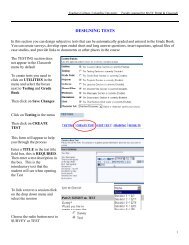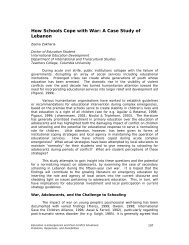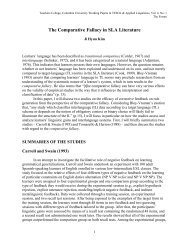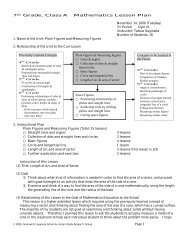UNICEF Mongolia - Teachers College Columbia University
UNICEF Mongolia - Teachers College Columbia University
UNICEF Mongolia - Teachers College Columbia University
You also want an ePaper? Increase the reach of your titles
YUMPU automatically turns print PDFs into web optimized ePapers that Google loves.
CHAPTER 1: INTRODUCTION<br />
1<br />
2<br />
3<br />
4<br />
5<br />
6<br />
As menoned previously, the weekly workload system is in effect in most EU countries, as well as in<br />
two of the parcipang countries of the <strong>UNICEF</strong> CEECIS study, namely, Bosnia and Herzegovina and FYR<br />
Macedonia. In the other parcipang countries of the <strong>UNICEF</strong> CEECIS study on teachers—Armenia,<br />
Kyrgyzstan, Moldova, Uzbekistan—teachers are hired under the stavka system.<br />
The 2007 salary reform in <strong>Mongolia</strong> is a remarkable case because it mirrors the shi from the weekly<br />
teaching load system to the total workload system. Thus, since September 1, 2007, teachers in schools<br />
and kindergartens of <strong>Mongolia</strong> have been paid for 40 hours of work per week, nineteen hours of which<br />
are assigned for teaching. 6 Prior to the fundamental salary reform of 2007, teachers were paid solely for<br />
the number of hours they were teaching. The next secon provides a historical overview of the teacher<br />
salary system in <strong>Mongolia</strong>.<br />
1.3. THE TEACHER SALARY SYSTEM IN MONGOLIA:<br />
A HISTORICAL SKETCH<br />
The main features of the two employment systems—teaching workload versus total workload—are<br />
summarized in Figure 2.<br />
Figure 2: Main Disncons between the Two Salary Systems<br />
TEACHERS IN MONGOLIA: AN EMPIRICAL STUDY ON RECRUITMENT INTO TEACHING,<br />
PROFESSIONAL DEVELOPMENT, AND RETENTION OF TEACHERS<br />
Teaching Load System<br />
(stavka system)<br />
Salary Base<br />
Number of Teaching Hours<br />
per Week (19 hours/week)<br />
Role of Teacher<br />
The teacher is reduced<br />
to teaching, and all<br />
other activities (including<br />
pedagogical ones) are paid<br />
extra.<br />
Income of Teacher<br />
Unpredictable income, small<br />
base salary for 1 teaching<br />
load. <strong>Teachers</strong> are therefore<br />
encouraged to teach<br />
additional hours or take on a<br />
job outside of school.<br />
Weekly<br />
Workload System<br />
Salary Base<br />
Number of Work<br />
Hours per Week (40<br />
hours/week)<br />
Role of Teacher<br />
The teacher is expected to<br />
carry out all activites related<br />
to instruction and is also<br />
expected to stay at school<br />
beyond the actual teaching<br />
hours.<br />
Áàãøèéí îðëîãî:<br />
Òîäîðõîé îðëîãî, áàãø<br />
íàð äàâõàð àæèë ýðõëýõèéã<br />
õîðèãëîäîã. /Öàãèéí áàãø<br />
áèø áîë/<br />
20<br />
Source: Modified figure from <strong>UNICEF</strong> CEECIS (2011).<br />
6 Joint Order of the Minister of Educaon, Culture and Science, the Minister of Social Protecon and Labor, and the Minister of<br />
Finance (2007).On adopng the procedure to set the work norms of kindergarten and generaon educaon school teachers, and<br />
to calculate and discharge the salaries of teachers and certain other officials. Date: August 31, 2007, Order: Number 307/91/237.<br />
Ulaanbaatar.














![TC Tod[...].pdf - Teachers College Columbia University](https://img.yumpu.com/27074883/1/190x252/tc-todpdf-teachers-college-columbia-university.jpg?quality=85)


